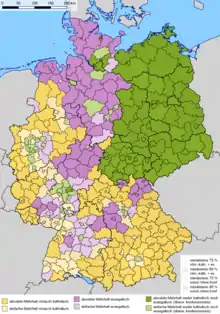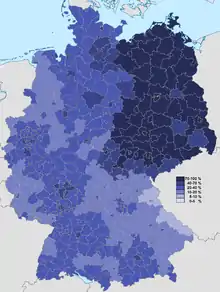Irreligion in Germany
Irreligion is prevalent in Germany. As of 2009, more Germans are non-believers in Eastern Germany than Western Germany.[1][2] When taken overall, Germany is a remarkably secular nation, though in spite of this, many areas in Western Germany don't have demographics of irreligion comparable to that of several nearby European countries.[3][4]

Light: relative majority (33.3 – 50%)

Eastern Germany is perhaps the least religious region in the world.[5][6] Atheism is embraced by young and old, though even more so by younger Germans.[7] One study in September 2012 was unable to find a single person under 28 who believes in God.[8] An explanation for this, popular in other regions, is the aggressive state atheist policies of German Democratic Republic's Socialist Unity Party of Germany. However, the enforcement of atheism existed only for the first few years. After that, the state allowed churches to have a relatively high level of autonomy.[9] As those born after reunification, the oldest of whom would be about 28 in 2018, never directly experienced it, the argument that the DDR could be an influence in their lack of belief is problematic.
Also, the same high numbers of atheists do not exist in Western Germany, other European countries that have a history of state communism and Northern Europe generally.
Another explanation could be the secularizing trend (the "Kulturkampf") dating back to the second half of the 19th century in Prussia and through the Weimar Republic which was strongest in the states of Thuringia and Saxony as well as the late arrival of Christianity to the region as opposed to southern Europe where it was the state religion from late antiquity.
Christianity still has a notable presence in the rest of Germany, though a majority of the population in the Northern Bundesländer Hamburg and Bremen are not registered members of the main Catholic and Protestant churches.[10][11]
A 2019 estimate shows that 38.8% of the German population were nonconfessional, not member of a religious group.[12]
| State[13] | Not religious (2011) | Percent of the population |
|---|---|---|
| 1,805,960 | 79.6% | |
| 1,229,350 | 77.5% | |
| 1,858,370 | 76.2% | |
| 2,908,420 | 72.6% | |
| 1,433,690 | 66.0% | |
| 2,045,340 | 62.6% | |
| 827,180 | 48.9% | |
| 251,770 | 38.9% | |
| 955,190 | 34.3% | |
| 26,265,880 | 33.0% | |
| 1,610,090 | 27.1% | |
| 1,992,670 | 25.8% | |
| 3,930,270 | 22.5% | |
| 2,248,600 | 21.6% | |
| 2,317,860 | 18.8% | |
| 720,000 | 18.1% | |
| 131,120 | 13.2% | |
See also
- Christianity in Germany
- Demographics of Germany
- Freedom of religion in Germany
- Islam in Germany
- Religion in Germany
References
- "Only the old embrance God". Spiegel. Retrieved 2012-07-02.
- "East Germany world's most Godless area". The Local. Retrieved 2012-07-02.
- "Global Index of Religiosity and Atheism" (PDF). Gallup. Retrieved 2012-09-02.
- "Eastern Germany: the most godless place on Earth | Peter Thompson | Comment is free | guardian.co.uk". Guardian. London. 2012-09-22. Retrieved 2012-09-22.
- "WHY EASTERN GERMANY IS THE MOST GODLESS PLACE ON EARTH". Die Welt. 2012. Archived from the original on 2012-08-26. Retrieved 2009-05-24.
- "East Germany the "most atheistic" of any region". Dialog International. 2012. Retrieved 2009-05-24.
- "Only the Old Embrace God in Former East Germany". Spiegel Online. 2012. Retrieved 2009-05-24.
- Thompson, Peter (2012-09-22). "East German atheism can be seen as a form of continuing political and regional identification – and a taste of the future". guardian.co.uk. London. Retrieved 2012-09-24.
- "Eastern Germany: the most godless place on Earth". theguardian. 2012. Archived from the original on 2012-08-26. Retrieved 2009-05-24.
- "Church Statistics". Archived from the original on 2018-12-25. Retrieved 2018-02-17.
- Church Statistics 2015
- FOWID Religionszugehörigkeiten 2019
- "Zensusdatenbank - Ergebnisse des Zensus 2011". Retrieved 27 December 2016.